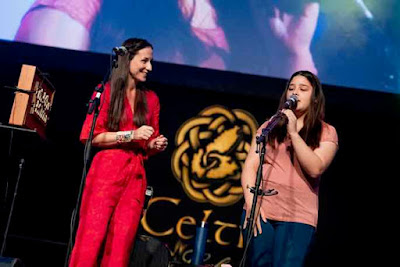Celtic Colours At Home: Connecting across landscapes, culture, and time
Celtic Colours: for twenty three years now this international festival has been celebrating culture, landscape, and above all music on Cape Breton Island in Nova Scotia in Atlantic Canada.
Warmth, welcome, music, and community spirit will all be part of the festival’s twenty fourth year 9 through 17 October. Things will be a bit different, though. You will be able to experience its unique atmosphere and offerings in your own home, through online events. This is Celtic Colours at Home.
Challenges: moving the festival online
Though it was not an easy decision to move on line -- and for logistics alone it was a decision which had to be made many months in advance of the the festival’s mid-October dates -- Celtic Colours had several things going for it in the transition.
Artistic Director Dawn Beaton has the responsibility of programming the festival. Celtic Colours usually presents more than fifty official concerts over its nine day span, and there are dozens of events including meals, ceilidhs, art exhbits, and more offered by community partners as well.
“Many factors were unknown,” Beaton said, “so I tried to approach the programming with the possibility that things could shut down again entirely, given October marshals the way for the traditional flu season. Even within family bands, if they were spread out over three or more households, back in March, that would have been impossible to present them on stage...For much of it, it was important to look at family clusters, duos or trios that would easily be accommodated on stage, to allow for physical distancing. Had things shut down, I felt confident we could still deliver the music as planned through other means.”
In addition to a strong presence of artists from Cape Breton, Celtic Colours always features artists from across Nova Scotia and the other Maritime provinces. Artists from elsewhere in Canada, along with overseas artists from Ireland, Scotland, and other places whose traditions have influenced music and culture on Cape Breton are integral parts of Celtic Colours as well.
It was important to keep this international aspect of the festival going, Beaton knew, in whatever ways they could figure out to do it. “In the end, it came down to the artists, and to community,” she said. Respect for Beaton, who is herself a top class fiddle player and step dancer in addition to her admin roles with Celtic Colours, no doubt played a part too. “Sometimes the plans didn't work out,” she pointed out, “but we have such a great group of artists who love the festival and wanted to do whatever they could to make it happen.”
There were many factors at work as festival staff adjusted to the idea of an entirely online event. “What was in our favour was the fact that we as the festival had been doing live-streaming [of one concert of the six or more presented every night] since 2011, so we knew we could continue in that capacity,” Beaton said. “We looked at a number of options; could we still travel around the island? Could we have an in-house audience? If not, would we need a paywall for the sake of the performances? Much was discussed and many things had to be ascertained in terms of government aid to see if we could proceed. When I look back at March and April, there was just so much uncertainty in what would be, come October,” she continued.
Collaboration and connection
Uncertainty, yes, but there were some things that were clear, both in vision and and practicalities. “We wanted the look and feel of our online presence to match prior years. That meant hiring a venue we've used in past years for the [in person] online portion, one we knew had strong internet and a stage capacity to give us the room for proper physical distancing, both on and off the stage. That came in the form of the Membertou Trade and Convention Centre, and it meant supporting our industry as well.”
As well as more than fifty concerts all across the island offered in person in past years, non profit groups and organizations and businesses offer community meals, walks, talks, informal music sessions, art exhibits, farmers’ markets, and other events. “We knew we weren't going to sell in-house tickets to any of the shows, so it meant fewer folks on the ground, putting our Community Cultural Experiences in jeopardy. It was also important for them to feel safe and stay healthy. That was first and foremost in all of our thoughts and actions, so for all of those reasons, we couldn't incorporate those wonderful experiences into the festival this year. And that was another tough blow,” Beaton said, “as economically, having our festival patrons here helps to bring revenue to these not-for-profits as well.”
Festival staff worked out a way to include some of this, though.“This will be an area we ensure comes back of course, but until then, we wanted to highlight a few of those great partners and approach this year as a chance to tell some of the stories of the island and what we love about it. Each night of the festival, our Outreach Coordinator, Yvette Rogers, takes us around the island to focus on a different region and speak to the history, the scenery and of course the people,” Beaton said.
Music at the heart
As with the in person festival, music remains at the heart of the online event.
So who are some of those artists you may hear at Celtic Colours at Home?
Internationally renown Gaelic singer Mary Jane Lamond is a longtime Celtic Colours favourite. Emma Stevens, who is still finishing up her high school course on Cape Breton, was a hit at last year’s celebration as she sang Blackbird in her native Mik’maq language, trading verses with Julie Fowlis from Scotland, who sang in Scottish Gaelic.
Piano and fiddle combinations are characteristic of Cape Breton music, whether other instruments are included or not. Hilda Chiasson is one of the most creative and in demand of Cape Breton pianists. She will be show up playing with a range of artists across Celtic Colours concerts.
This year’s Artists in Residence each have a long history with the Festival. Fiddle player Troy MacGillivray, is from Antigonish County, Nova Scotia, and flute player and singer Nuala Kennedy, is originally from County Louth and now living in Ennis in Ireland. They have enjoyed performing together before, and word comes that they have been planning out surprises for this online event, when Nuala will join in remotely from her home in Ireland and Troy will be onstage in Cape Breton. Troy will be joined by siblings Kendra and Sabra MacGillivray, while Nuala’s performances will include Tara Breen on fiddle, Tony Byrne on guitar, and dancer Siobhán Butler.
Guitarist Kaia Kater will join in remotely too, from Ontario. She will be bringing her creative musical ideas which fuse and blend Caribbean, Appalachian, and Canadian elements.
Beolach, a group whose core members are Mairi Rankin, Mac Morin, and Wendy MacIsaac, brings deep knowledge and love of Cape Breton music as well as its heritage in the musics of Scotland and Ireland. Last year they shared Artist in Residence honours with the band Breabach, from Scotland.
You may also recall the members of Beolach becoming part of The Unusual Suspects of Cape Breton, a Celtic big band project led by Corrina Hewat and Dave Milligan. No big band this season, but Hewat and Milligan will be joining in with their own music from their home in Scotland.
Innovative Cape Breton fiddle player Ashley MacIsaac will be part of the opening concert, and he’ll be a part of a continuing Celtic Colours tradition of including up and coming artists, as he shares the stage with We’koma’q First Nation fiddler Morgan Toney, Mary Beth Carty, and Stoney Bear Singers from Eskasoni First Nations for a cross cultural collaboration.
Scottish, Irish, Manx, First Nations, and Acadian music will all form part of the festival as musicians make their ways through concerts called, among others, Right at Home, Bell without a Tongue, and Through the Generations. Things will conclude on the final night with a concert featuring French Canadian band Vishten and along with long time festival favourites The Barra MacNeills, who created and channel Cape Breton and Scottish music in English and in Gaelic. This concert is called The Bright Side. If you’re up for it, an after hours festival club will close out the last night of Celtic Colours at Home.
Celtic Colours at Home: connecting across miles, culture, and time There will not be listeners in person in seats this season, but there will nevertheless be community and connection.
“It's showing others, be it folks that always came to our live performances, or new folks that have never ever heard of the Celtic Colours International Festival what Cape Breton is all about, what shared ancestry we have, and to celebrate the differences amongst us too,” Artistic Director Dawn Beaton reflected. “I hope folks will celebrate great music and camaraderie and maybe find new favourites this year. And as always to show the importance of culture, as a means of inclusion, never to divide us.”
Celtic Colours at Home: adapting to different circumstances, it it remains a celebration of connection, community, and music in the unique place that is Cape Breton.
Photograph of Dawn Beaton by Ryan MacDonald. Photograph of The Barra MacNeills courtesy of the artists. Other artists photographs (Anna Massie and Kristan Harvey, Cathy Peterson and Mary Jane Lamond, Julie Fowlis and Emma Sweeney, Wendy MacIsaac and Mac Morin, Corrina Hewat) by Corey Katz, courtesy of the Celtic Colours International Festival
There will be one concert on each of nine evenings, 9 through 17 October. On the two Saturdays in this span, there will be a second concert, honoring the Celtic Colours tradition of late night festival club celebrations. Some artists will be on stage and others will join in virtually. The concerts are produced in partnership with NovaStream and Soundpark Studios. Celtic Colours at Home is presented by TD Bank Group, with the support of ACOA, Canadian Heritage, the Province of Nova Scotia, and its many other partners. For information on this year's Festival, artists and the schedule, visit the festival’s web site at https://celtic-colours.com
You may also wish to see
A look back at Celtic Colours 2017
At Wandering Educators, Geography of Inspiration: Music and Place includes music from Dawn Beaton and her sister Margie
At Perceptive Travel, Exploring Cape Breton Island through Celtic Colours
Another musical collaboration which may be of interest: The Lost Words: Spell Songs
-->Your support for Music Road is welcome and needed. If you are able to chip in, here is a way to do that, through PayPal. Note that you do not have to have a PayPal account to do this. Thank you.
Labels: autumn, canada, cape breton, cape breton music, celtic colours, creativity, fall festivals, festivals, nova scotia
















0 Comments:
Post a Comment
Subscribe to Post Comments [Atom]
<< Home